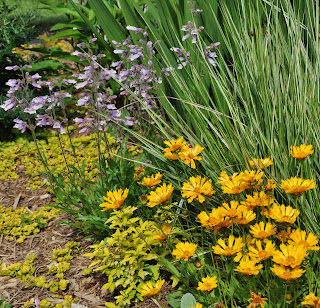Following up on Allium Forelock, here are two flowers a month later. While they are still much the same size, they are slowly transforming in seed heads. I'll have to decide whether to harvest the seeds, and see if they will grow. I don't want them to scatter about, because if they are viable that would be dozens of new plants, most likely growing in the grass.
I promised to have more to say about the orange foxglove. That will have to wait until I can confirm the proper name. I thought I knew it, but a closer examination makes me suspicious. The problem of knowing the proper name soon will be solved by the list of plants I am compiling in digital form, from 12 years of journal entries and a bag full of plant labels.
One of the nice May combinations can be seen on the right. The lavender blue flower is a native Penstemon smalli bought from the now closed Lower Marlboro Nursery. The yellow flower is Coreopsis 'Jethro Tull' with a ground cover of Moneywort (Lysimachia nummularia) - which has not been added to the list, so I cannot specify the variety. Unfortunately, the Feather Reed Grass on the right is also still unlisted. Give me a break, I just started to work on the list this week and am up to 2004.
Here is a close-up of the Penstemon flowers.
The Penstemon blooms for 3-4 weeks, with the Coreopsis starting in the second week and continuing on for about six weeks. With regular deadheading, the Coreopsis puts up new flowers, though they get smaller and more sparse, until it is done by the end of June.
Another plant that came from the closed nursery is the Purple Milkweed, Asclepias Purpurascens. The original three plants, that were little more than seedlings, have taken three seasons to get established and grow large enough to bloom. This year they came into full glory, with large clusters of flowers. They sit among a group of other tall perennials including a hardy hibiscus, visible on the left, Russian Sage, appearing behind and on the right.
Soon they will fade into the background when the hibiscus starts opening its huge, dark red flowers. But for about three weeks they offer a warm color and disguise the still stretching stalks of the hibiscus.
Milkweeds provide food to a variety of insects, and are famous as a food source for caterpillars of Monarch butterflies as well as other insects. Until doing research for this entry, I didn't realize that the caterpillars ingest and store the bitter and toxic chemicals in the milkweed leaves they feed upon, which protects them from being eaten by birds.
Speaking of insects, here is a visiting butterfly enjoying the nectar of the milkweed! Now if it will also lay some eggs, maybe you will see a complete life-cycle? Stay tuned.
Finally, here is a super-sized Verbena bonariensis on the edge of the sidewalk. These tender perennials are usually killed in the winter time, but this one survived the mild weather. Of course, it blocks half of the sidewalk, which David thinks is just wonderful. It will need to be pruned back heavily to encourage re-blooming, but recovery is quick. A hat tip to Christopher Lloyd of Great Dixter, England, where I first fell in love with these.






No comments:
Post a Comment